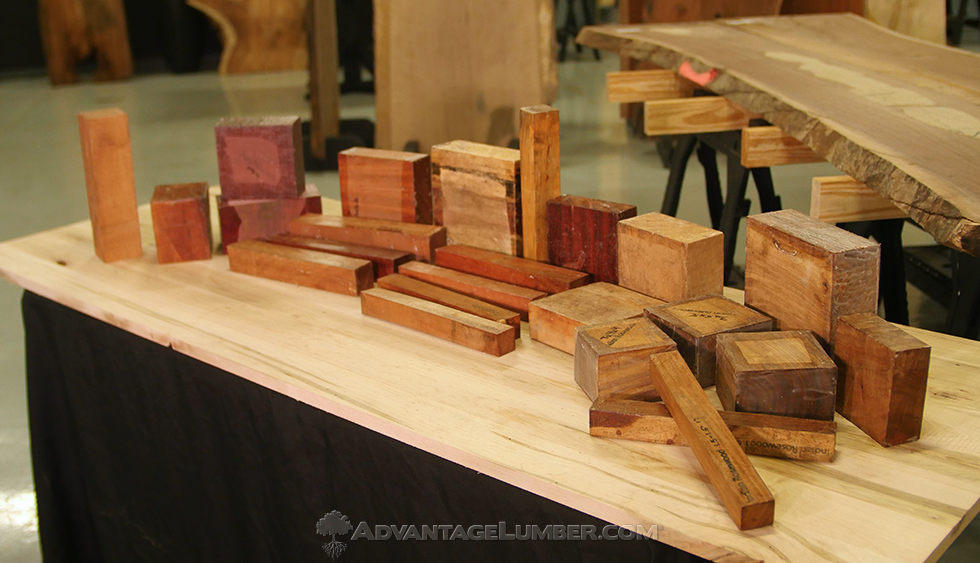Gaboon Ebony Turning Blanks

Gaboon Ebony Turning Blanks
Buy Online
All Turning Blanks
Shop NowGaboon Ebony Specs
- Scientific Name
- Diospyros crassiflora
- Common Name(s)
- Gaboon Ebony, African Ebony, Nigerian Ebony, Cameroon Ebony
- Distribution
- Equatorial West Africa
- Average Dried Weight
- 60 lbs/ft3 (955 kg/m3)
- Specific Gravity
- Basic: .82, 12% MC: .96
- Janka Hardness
- 3,080 lbf (13,700 N)
- Modulus of Rupture
- 22,930 lbf/in2 (158.1 MPa)
- Elastic Modulus
- 2,449,000 lbf/in2 (16.89 GPa)
- Crushing Strength
- 11,060 lbf/in2 (76.3 MPa)
- Shrinkage
- Radial: 8.3%, Tangential: 11.2%, Volumetric: 19.6%, T/R Ratio: 1.3
- Appearance
- Heartwood is usually jet-black, with little to no variation or visible grain. Occasionally dark brown or grayish-brown streaks may be present.
- Texture
- Grain is usually straight but can also be interlocked. Fine even texture with very high natural luster. Endgrain: Diffuse-porous; medium to large pores in no specific arrangement, few; solitary and radial multiples of 2-3; black mineral deposits present; growth rings indistinct; rays not visible without lens; parenchyma reticulate/banded, possibly marginal, apotracheal parenchyma diffuse-in-aggregates, paratracheal parenchyma vasicentric.
- Rot Resistance
- Ebony is rated as being very durable, with good resistance to termites and other insects.
- Workability
- Can be difficult to work due to its extremely high density. Has a dulling effect on cutters. Tearout may occur on pieces that have interlocked or irregular grain. Due to the high oil content found in this wood, it can occasionally cause problems with gluing. Finishes well, and polishes to a high luster. Responds well to steam bending.
- Odor
- Ebony has a mild, slightly unpleasant odor when being worked.
- Allergies/Toxicity
- Although severe reactions are quite uncommon, Ebony in the Diospyros genus has been reported as a sensitizer. Usually most common reactions simply include eye, skin, and respiratory irritation.
- Pricing/Availability
- Gaboon Ebony is among the most expensive of all available lumbers: usually about two to three times more expensive than most species of Rosewood. The small size of the tree, and its high demand for ornamental work may contribute to its seemingly outlandish price.
- Sustainability
- This wood species is in CITES Appendix II (for Diospyros species from Madagascar), and is on the IUCN Red List. It is listed as endangered due to a population reduction of over 50% in the past three generations, caused by exploitation.
- Common Uses
- Small/ornamental items, such as piano keys, musical instrument parts, pool cues, carvings, and other small specialty items.
- Comments
- So named because historically most of the wood was exported from the nation of Gabon, though today it’s much more likely to be sourced from Cameroon. There’s no mistaking Gaboon Ebony as there are few woods that are deep and solid black (unless dyed), and even most species in the Diospyros genus aren’t black. Other types of ebony include: Macassar (striped) Ebony, and Black and White Ebony. African Blackwood is very similar in density, color, and (unfortunately) cost, but is technically in the Dalbergia genus and isn’t considered a true ebony. Wenge and Katalox are two woods that are sometimes used as an ebony substitute. The wood is exceptionally dense, strong, and stiff, though it is considered to have moderate to poor stability through seasonal changes.
Gaboon Ebony Turning Blank Prices
2″ x 2″ x 12″ Gaboon Ebony Turning Blank
$49.00
Buy Online

